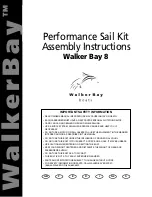
NI 449
x
Calibration Procedure | © National Instruments | 5
Calibration Procedures
The calibration process includes the following steps:
1.
—Install the device and configure it in Measurement & Automation Explorer
(MAX).
2.
—Adjust the self-calibration constants of the device.
3.
—Verify the existing operation of the device. This step confirms whether the
device is operating within the published specifications prior to adjustment.
4.
—Adjust the calibration constants of the device. The adjustment procedure
automatically stores the calibration date on the EEPROM.
5.
Reverification
—Repeat the verification procedure to ensure that the device is operating
within the published specifications after adjustment.
These procedures are described in more detail in the following sections.
Initial Setup
Refer to the
DAQ Getting Started
guides for information about how to install the software and
hardware and how to configure the device in MAX.
Self-Calibration
The NI 449x includes precise internal circuits and references used during self-calibration to
adjust for any errors caused by short-term fluctuations in the environment. Self-calibration does
not require external signal connections.
Note
Allow a 15 minute
warm-up period before you begin self-calibration.
Initiate self-calibration from MAX. To initiate self-calibration, complete the following steps:
1.
Launch MAX.
2.
Select
My System»Devices and Interfaces
.
3.
Select the device that you want to self-calibrate.
4.
Initiate self-calibration in one of the following ways:
•
Click
Self-Calibrate
in the upper right corner of the window.
•
Right-click the device name under Devices and Interfaces, and select
Self-Calibrate
from the drop-down menu.
Verification
This section provides instructions for verifying the NI 449x specifications. By completing this
procedure, you can see how device accuracy has drifted over time, which helps you determine
the appropriate calibration interval for your application.
Note
Test limits in Tables 3 through 8, and Tables 13 through 15 are based upon the
May 2012 edition of the
NI 449x Specifications
. Refer to the most recent
NI 449x
Specifications
online at
ni.com/manuals
.






































